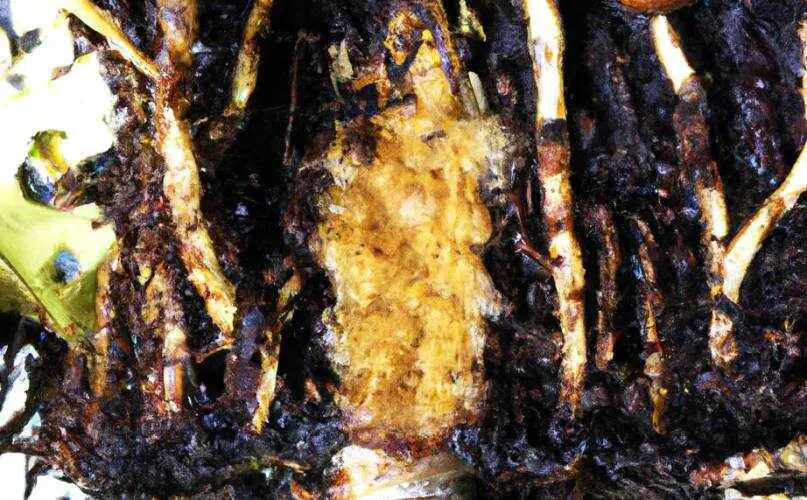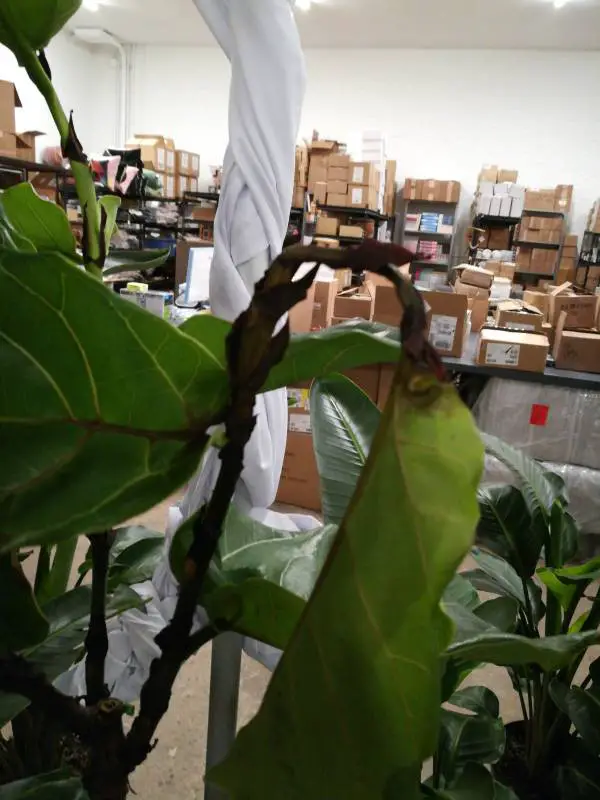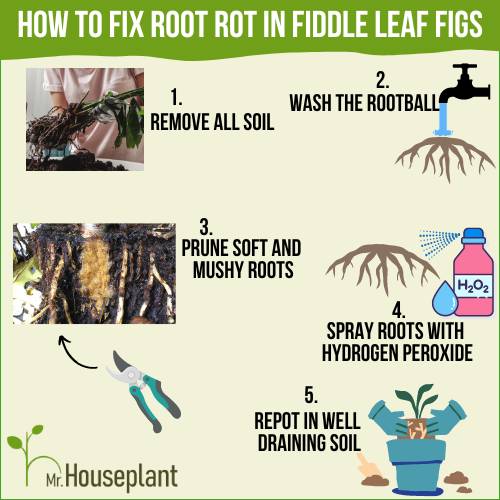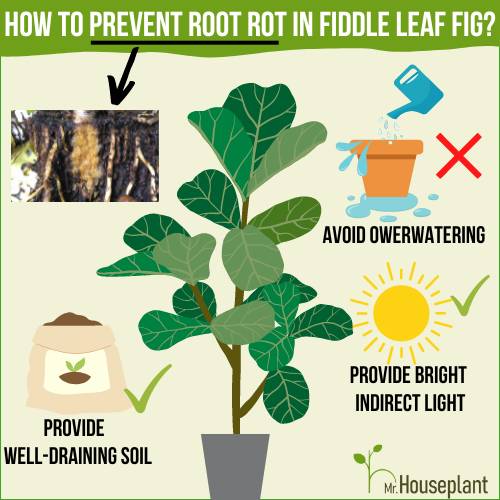
Are you afraid that Fiddle Leaf Fig root rot will kill your lovely plant? Perhaps you’re unsure what are the symptoms of root rot? This comprehensive blog post will equip you with all the knowledge to save your plant. You will learn how to recognize the symptoms of root rot in Fiddle Leaf Fig, how to treat the afflicted plants, and how to prevent root rot in Fiddle Leaf Fig.
Fiddle Leaf Fig Root Rot (Key Takeaways)
Root rot is caused by overwatering. The signs are soft and mushy roots, brown leaf spots and leaves falling off. To fix root rot remove all soil, wash the rootball, prune soft and mushy roots, spray roots with hydrogen peroxide, and repot your Fiddle Leaf fig in well draining soil. To prevent root rot in the future avoid overwatering, provide bright indirect light and use well draining soil.
Signs Of Root Rot In Fiddle Leaf Figs
The signs of root rot in Fiddle Leaf Figs are soft and mushy roots, brown spots on the leaves, yellowing and wilting of the leaves, stunted growth, and leaves falling off.
If your Fiddle Leaf Fig looks droopy or sick, this may indicate a root rot problem. However, many other diseases can cause symptoms on the leaves, so the best way to be sure that the culprit of your Fiddle Leaf Fig’s decline is root disease, is to take a close look at its root system.

Unlike healthy roots that are white, roots suffering from root rot are mushy and brown
Take your Fiddle Leaf Fig tree out of the pot and inspect the root ball. Healthy Fiddle Leaf Fig’s roots are orange or white and firm. Healthy root system shouldn’t have an odor. Roots with root rot are mushy, soft, and they have an unpleasant odor.
It’s important to act quickly when you notice signs of root rot. Damaged roots can’t absorb oxygen and nutrients and if the disease spreads, it will eventually kill your Fiddle Leaf Fig.
Causes Of Root Rot In Fiddle Leaf Figs
Overwatering causes root rot in Fiddle Leaf Figs. When a plant sits in soggy soil, its roots cannot absorb oxygen and nutrients properly. Wet soil is the perfect breeding ground for fungi-like pathogens that cause Fiddle Leaf Fig root rot. The most common pathogens responsible for root rot are Pythium spp., Phytophthora spp., and Fusarium spp. They thrive in poorly drained potting mixes, so it’s vital to grow your Fiddle Leaf Fig in a porous, well-draining mix, and to avoid overwatering.

Overwatered Fiddle Leaf Fig is more prone to root rot
Can A Fiddle Leaf Fig Recover From Root Rot?
Yes, Fiddle Leaf Fig can recover from root rot, but only if the problem is detected early. This is why it’s important to be vigilant and regularly inspect your Fiddle Leaf Fig and assess its health. At the first sign of root rot, you should repot your plant, prune all the soft, mushy, and rotting roots and give your Fiddle Leaf Fig direct sunlight. If the root rot spreads, it’s almost impossible to save your Fiddle Leaf fig, and in that case, the best thing you can do is to discard the plant and buy a new one.
How To Fix Root Rot In Fiddle Leaf Figs?
To fix root rot in Fiddle Leaf Figs take the following steps: remove all soil, wash the root ball and examine the plant’s roots, prune diseased roots, spray remaining roots with hydrogen peroxide, fill a new pot with well draining soil and repot your Fiddle Leaf fig.

1) remove all soil 2) wash the rootball 3) prune soft and mushy roots 4) spray roots with hydrogen peroxide 5) repot in well draining soil
Your Fiddle Leaf Fig will have the best chances of survival and full recovery if you recognize the early signs and act promptly. Take a good look at the root ball of the Fiddle Leaf Fig plant. Are the roots smelly and mushy? Is the soil soaked? If the answer is yes, you should immediate activate to fix root rot and save your Fiddle Leaf Fig.
First, wash the root ball and examine the roots. Healthy roots are firm and orange or white. Use sterilized pruning shears or scissors to prune all the damaged roots that have turned brown or mushy.
Mix 1 part 3% hydrogen peroxide with 15 parts water and pour the solution into a spray bottle. Spray the plant’s roots with the hydrogen peroxide solution. After pruning, some of harmful bacteria and fungi can remain on the roots, so by spraying the Fiddle Leaf Fig roots you will kill any remaining pathogens on them. You can also use this solution to spray the new pot to sterilize it.
Next, take a new pot with drainage holes, and fill it with a well-draining, porous potting mix. To make the soil more porous and oxygenated, you can add amendments such as perlite, bark, or vermiculite to any store bought potting mix.
Choose the right pot size, because a pot that is too large will retain too much moisture and the soil will take more time to dry out. When repotting your Fiddle Leaf Fig, choose a pot that is 2 inches larger in diameter than the one you’ve been using.
Repot your Fiddle Leaf Fig, water the plant, and put it in a spot where it can get enough direct sunlight. Even if the plants are grown in well-draining soil and pots, they’re susceptible to root rot if they don’t get enough light.
Is Root Rot Contagious? Can It Spread To Other Plants?
Although pathogens responsible for root rot are present in soil and could be spread to other pots (for example if you reuse water from one plant to water another plant), specific conditions have to be met in other pots for the pathogens to multiply and lead to root rot. Those conditions are overwatering, lack of light and poor potting mix. Only in this case bacterial or fungal diseases that cause the root rot can spread to another plant.
How To Prevent Root Rot In Fiddle Leaf Fig?
The best way to prevent root rot in Fiddle Leaf Fig is to avoid overwatering, provide bright indirect light and make sure the plant is in well-draining soil. Water your Fiddle Leaf Fig Tree only when the soil has dried out all the way to the bottom of the pot. The watering schedule will depend on the conditions in which the plant is grown, such as humidity, plant size, how much light the plant gets, potting mix, pot material, etc. After some time you will be able to properly assess Fiddle Leaf Fig’s water requirements and establish your own watering schedule.

Overwatering, lack of light and poor soil can cause root rot in Fiddle Leaf Fig
Also, when you’re buying Fiddle Leaf Fig plants, ask the seller to show you the root ball and pick a plant with healthy roots. Sometimes, the plants sold in plant shops already have root rot. That’s why it’s important to choose a plant with a robust and healthy root system. You should always ensure that the pot you’re using has drainage holes because otherwise the soil will hold excess water and the plant will be more prone to root rot.
Repot a Fiddle Leaf Fig at least once a year to provide it with fresh soil that is packed with nutrients. This will give your plant all it needs to thrive and fend off the pathogens causing root rot.
Yours Truly,


Related Posts
Sansevieria Black Gold (Snake Plant Care GUIDE!)
Spathiphyllum Sensation (FULLY Explained!)
Alocasia Stingray Care